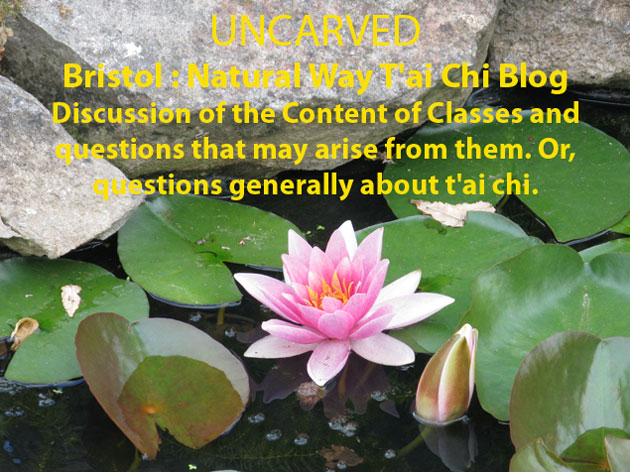Sunday, 24 May 2009
Monday, 18 May 2009
Saturday, 16 May 2009
Thursday, 7 May 2009
Adjusting the qualities of Body and Mind
When we experience the body in the ordinary way it feels relatively dense and heavy. It does not feel naturally agile and easy to move. The mind is generally full of content - thoughts, perceptions and impressions.
One of the principles of t'ai chi is to coordinate the mind and chi and in this way move the body. Yet the body is very different from the chi and mind. The mind and chi are subtle and spacious in their natural state. So we cultivate a softer, lighter state in the body. We make the body feel more like the chi. This can be achieved in different ways. We can align the body carefully, sink the dense feeling by relaxing deeply and then suspend the crown of the head. Also we can make the body feel light and sensitive such that if a fly landed on the body, or a feather, then the whole of the body would respond to that weight! In this way the body is atuned to the feeling of the chi.
The mind can be encouraged to settle and be still and peaceful and spacious with no thought. From this state the intention can be clear and uncomplicated and lead the chi.
One of the principles of t'ai chi is to coordinate the mind and chi and in this way move the body. Yet the body is very different from the chi and mind. The mind and chi are subtle and spacious in their natural state. So we cultivate a softer, lighter state in the body. We make the body feel more like the chi. This can be achieved in different ways. We can align the body carefully, sink the dense feeling by relaxing deeply and then suspend the crown of the head. Also we can make the body feel light and sensitive such that if a fly landed on the body, or a feather, then the whole of the body would respond to that weight! In this way the body is atuned to the feeling of the chi.
The mind can be encouraged to settle and be still and peaceful and spacious with no thought. From this state the intention can be clear and uncomplicated and lead the chi.
Friday, 1 May 2009
Releasing an arm lock
If our elbow joint is attacked and we feel force from an opponent we must relax so that the force does not meet with resistance. During the act of relaxing the opponent's force moves to try to maintain the force. When the movement occurs you must introduce a rotation of the arm to move the elbow joint away from the force.
It is important to note that when you relax the arm you actually relax the whole of the body and especially the upper body. It is not sufficient to just relax the arm muscles. If you do this you will not be able to release your opponent's force.
It is also necessary to match your opponent's speed.
Finally if an opponent is able to apply a force towards your joint it is a little too late and so improving your sensitivity, whole body coordination and lightness will avoid such problems.
It is important to note that when you relax the arm you actually relax the whole of the body and especially the upper body. It is not sufficient to just relax the arm muscles. If you do this you will not be able to release your opponent's force.
It is also necessary to match your opponent's speed.
Finally if an opponent is able to apply a force towards your joint it is a little too late and so improving your sensitivity, whole body coordination and lightness will avoid such problems.
Using muscles then releasing them
Whenever we move of course we use our muscles. However during t'ai chi we use muscles to make a particular movemement and then we should release the strength from those muscles before we begin the next movement. For example, if we take a step, after the stepping foot has landed we need to let go of the muscle strength and allow the leg to rest before shifting the weight. To begin with this means that you practice very slowly but the habit becomes natural before too long.
Dr. Chi liked to call t'ai chi 'resting in movement.'
Generally the body feel as if we have no strength. This feeling is produced when all of the muscles are as relaxed as possible. Using t'ai chi principles of movement the whole body moves as one piece so it feels as if we don't use any muscles but in fact we use all of the muscles in a coordinated way. When we do this we can't feel individual muscles working harder and it feels as if we don't use any.
Dr. Chi liked to call t'ai chi 'resting in movement.'
Generally the body feel as if we have no strength. This feeling is produced when all of the muscles are as relaxed as possible. Using t'ai chi principles of movement the whole body moves as one piece so it feels as if we don't use any muscles but in fact we use all of the muscles in a coordinated way. When we do this we can't feel individual muscles working harder and it feels as if we don't use any.
Subscribe to:
Posts (Atom)
